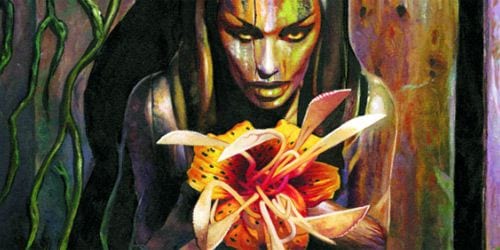
Serial killers are kind of played by now, aren’t they? There have been countless movies (Zodiac, The Silence of the Lambs et al, Seven, Dahmer, Copycat), books (The Alienist, Cellar of Horror, Shadow Man) and now even TV shows (Dexter). We’ve had Charles Manson and Aileen Wuornos, Helter Skelter and Monster. Jack the Ripper’s been immortalized in numerous films and books, including Alan Moore and Eddie Campbell’s From Hell. There really isn’t much more to add, is there? They’re out there, they’re sick, that’s about it.
Peter Straub begs to differ. His 1993 novel The Throat contained the character Fielding Bandolier, a man whose obsession involved murdering young, attractive women. Given the success of the book (the third in a bestselling trilogy that also included Koko and Mystery), maybe my judgment about serial killers is off the mark. Maybe there is something more to say about them.
How else to explain the return of Fielding Bandolier in this Vertigo graphic novel, co-written by Straub and Michael Easton (Soul Stealer), with vivid painted art by John Bolton? Bolton, whose previous work includes Harlequin Valentine with Neil Gaiman and The Furies with Mike Carey, brings a sinister flair to the material, which elevates it above the run-of-the-mill “gritty” comic. The story itself, however, is hackneyed.
It seems that Bandolier is haunted by the women he murdered years ago. We know this because the story opens with him sitting in an abandoned tavern called The Green Woman, where he is being haunted by the women he murdered years ago. These hauntings are vividly portrayed by Bolton’s artwork—eyeballs looking back from the drains of the sink and so on—but as far as the story goes, there is nothing new here.
Fielding’s backstory is told through a series of flashbacks, the most compelling of which concerns his time fighting in Vietnam. The scenes are gruesome and visceral, although they do raise questions about Fielding’s age—a 20-year-old in Vietnam in 1968 would be 62 years old today, but the character looks barely middle aged. It would have made more sense for him to be a Gulf War vet, or for him to appear conspicuously older.
The other major player in this tired drama is Bob Steele, a jaded cop who does things his own way and gets in trouble for it. (Stop me if you’ve heard this one before.) Steele was named after a ’50s Hollywood cowboy of the same name, something mentioned often enough to suggest that there is some great significance to it, although the significance never becomes altogether clear. He has been preoccupied with serial killers over the course of his career, and his failure to apprehend Bandolier has, perhaps, contributed to his hard-living lifestyle, which seems to involve plenty of booze and broads.
Inevitably, the story leads to a showdown between these two figures, and a friendly chat does not ensue.
There are some innovations within the story, even if the material feels familiar and clichéd. Straub and Easton jump around in time a great deal—not all flashbacks are as clear as the Vietnam episodes, so the reader has to pay attention in order to make sense of the convoluted chronology. There is plenty of tension and energy in certain scenes, as when Steele goes nightclubbing or gets interrogated by police investigators. The supernatural elements, which are present throughout but never take a turn into fairy-tale silliness, are deftly handled.
By far the strongest thing this book has going for it is the artwork. John Bolton’s fully-painted pages verge on photorealism—at times, I would swear that he is, in fact, working off of retouched photographs. The color palette ranges from pale pastel shades of blue and pink and green to murky, shadowy images consuming an entire page. Splashes of bright color, for example blood, are used effectively. The straightforward panel layouts keep one’s eye moving both vertically and horizontally, with the occasional particularly striking image for the reader to linger over.
Bolton is also an accomplished illustrator of the human figure, which skill he puts to good use here. This may sound like faint praise but it’s not: it is truly remarkable how many comics artists out there are hopeless at drawing people.
Frustratingly, the review copy of The Green Woman sent by Vertigo is an almost entirely black-and-white advance edition; the opening dozen pages are full color, as a sample of the art as a whole, but the rest of the book is illustrated in grayscale. This is frustrating for me both as a reader and as a reviewer; I can neither enjoy the artwork as it is meant to be seen, nor can I properly report its effectiveness apart from the opening pages. (Note to Vertigo: splash out for full-color review copies of full-color books, especially those which, like this one, are lavishly painted and bear close study.) This is especially maddening given that the artwork is clearly the superior element in this book.
Anyone buying the book will do so for the art, and that may well be reason enough. As for the story — move along, folks, there’s nothing to see here.

![Call for Papers: All Things Reconsidered [MUSIC] May-August 2024](https://www.popmatters.com/wp-content/uploads/2024/04/all-things-reconsidered-call-music-may-2024-720x380.jpg)



